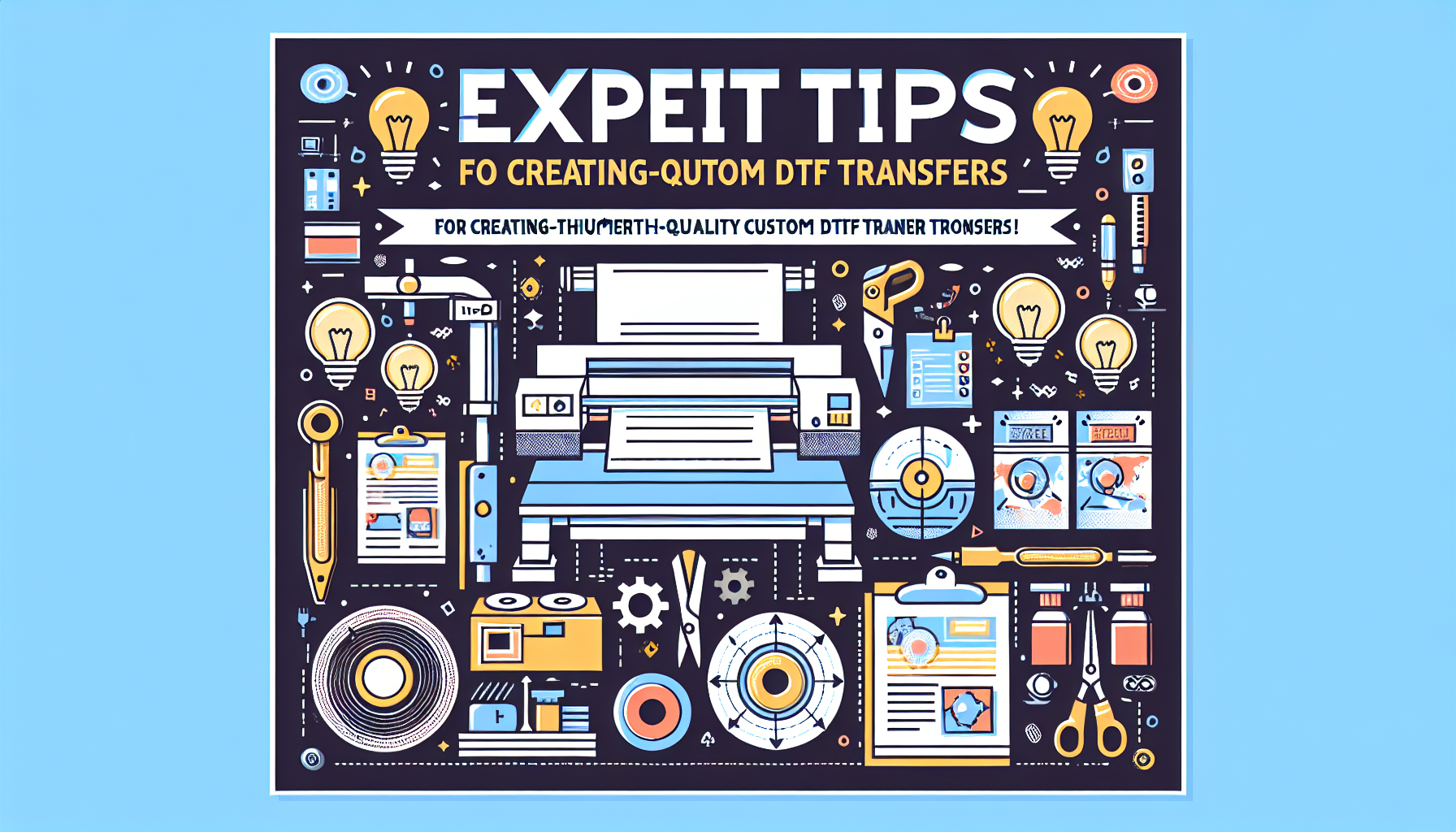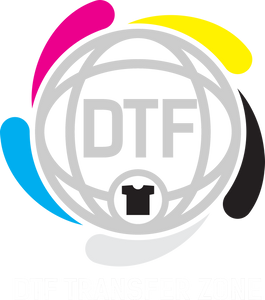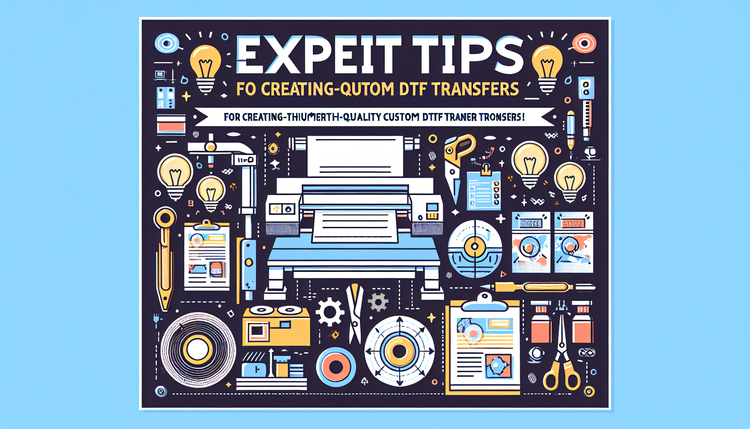Introduction

Direct-to-film (DTF) transfers have quickly gained traction in the garment decoration industry due to their versatility, ease of use, and ability to deliver high-quality printing results. By providing expert tips for creating exceptional custom DTF transfers, this blog aims to help you harness the full potential of this innovative printing technology and elevate your designs to new heights.
Tip 1: Choose the Right Design Software and File Format
When it comes to creating high-quality custom DTF transfers, selecting the appropriate design software is of utmost importance. Using software specifically designed for DTF transfers ensures compatibility with the printing process and allows you to optimize your designs for the best possible results. Popular design software options include Adobe Illustrator and CorelDRAW, both of which cater to the needs of DTF transfer artists.
Adobe Illustrator and CorelDRAW both offer a range of tools and features to help you create intricate and eye-catching designs. While Adobe Illustrator is widely recognized for its powerful vector-based capabilities, CorelDRAW is known for its user-friendly interface and robust design features. The choice between these two software options largely depends on your personal preferences and familiarity with each program.
Alongside selecting the right design software, it is crucial to use the recommended file formats for DTF transfers. Vector files, such as AI or EPS formats, are ideal for retaining sharp lines and edges in your design, while high-resolution raster images, such as PNG or TIFF files, can ensure crisp and vibrant prints. Choosing the correct file format contributes significantly to the overall quality and longevity of your custom DTF transfers.
Tip 2: Master the Art of Color Management
Color management is a critical aspect of creating visually appealing and accurate custom DTF transfers. To ensure vibrant and consistent colors in your DTF transfers, it is essential to understand the difference between RGB and CMYK color modes and how to effectively convert your designs for optimal printing results.
RGB (Red, Green, Blue) is a color mode typically used for digital displays, such as computer monitors and televisions, while CMYK (Cyan, Magenta, Yellow, Key-Black) is the standard color mode for printing processes, including DTF transfers. Due to these differences, colors that appear vibrant in RGB mode may not be accurately reproduced when printed in CMYK mode.
To achieve accurate and consistent colors in your custom DTF transfers, it is crucial to convert your designs from RGB to CMYK mode before printing. Most design software programs, such as Adobe Illustrator and CorelDRAW, offer built-in color management tools that allow you to easily convert your designs and preview the results. By converting your designs, you can ensure that the colors in your printed DTF transfers accurately represent your original vision and maintain their vibrancy throughout the printing process.
Tip 3: Optimize Your Artwork for DTF Printing
When creating custom DTF transfers, it is vital to optimize your artwork to achieve the best possible print quality. One crucial aspect of this process is avoiding soft edges and maintaining sharp lines in your design. Soft edges can lead to blurred or distorted prints, while sharp lines ensure crisp and clear results.
Another important factor in optimizing your artwork is incorporating small details without compromising print quality. With DTF printing, you can achieve intricate designs that were once difficult or impossible with traditional printing methods. However, it is essential to balance the level of detail with the capabilities of your DTF printer, ensuring that the final print accurately reflects your original design.
Lastly, creating eye-catching and unique designs is paramount to making your custom DTF transfers stand out on garments. Experiment with various techniques, such as gradient fills, textures, and patterns, to add depth and interest to your designs. By continually refining your design skills and staying up-to-date with the latest trends and techniques, you can produce exceptional custom DTF transfers that capture attention and showcase your creativity.
Tip 4: Utilize High-Quality DTF Supplies and Equipment
One key factor in achieving exceptional custom DTF transfers is the use of high-quality DTF supplies and equipment. The quality of your DTF ink, transfer film, and adhesive powder can significantly impact the final results. By investing in premium supplies, you can ensure that your custom DTF transfers are vibrant, sharp, and long-lasting.
DTFTransferZone is a trusted provider of a wide range of DTF products and supplies, offering fast shipping and competitive prices. Their selection includes top-quality DTF inks, transfer films, adhesive powders, and printer parts, ensuring that you have access to everything you need to create stunning custom DTF transfers. By choosing DTFTransferZone for your DTF supply needs, you can focus on perfecting your designs while trusting that you're working with high-quality materials.
In addition to their extensive range of DTF supplies, DTFTransferZone also offers custom DTF transfers with no setup or art fees and no order minimums. This service allows you to experiment with your designs without the burden of additional costs or the pressure of large order commitments. By taking advantage of DTFTransferZone's custom transfer services, you can confidently bring your creative vision to life and showcase your skills in the DTF printing process.
Tip 5: Properly Prepare and Execute the DTF Transfer Process
Ensuring that your custom DTF transfers are consistent and long-lasting starts with properly preparing and executing the DTF transfer process. First and foremost, it is essential to follow the manufacturer's instructions for DTF printer settings and heat press application. Each printer and heat press may have unique requirements for temperature, pressure, and dwell time. Adhering to these guidelines guarantees the best possible results for your custom DTF transfers.
During the transfer process, several common issues can arise, such as ink smudging and improper adhesion. To avoid these problems, follow these tips:
- Ensure that your transfer film is correctly aligned with your design before printing.
- Allow the printed transfer film to dry completely before applying the adhesive powder.
- Preheat your garment to remove any moisture that could affect the transfer's adhesion.
- Apply even pressure across the entire design during heat pressing to ensure proper bonding.
Lastly, proper post-press care and maintenance are crucial for maintaining the quality and longevity of your custom DTF transfers. Follow garment care instructions, such as washing and drying guidelines, to keep your designs looking fresh and vibrant. By paying close attention to each step of the DTF transfer process, you can ensure that your custom DTF transfers stand the test of time and continue to impress your clients and customers.
Unlock Your DTF Potential
We have explored expert tips for creating high-quality custom DTF transfers, such as selecting suitable design software, mastering color management, optimizing your artwork, utilizing top-notch DTF supplies, and properly preparing for the DTF transfer process. Remember, continually refining your DTF transfer skills and experimenting with new techniques is key to staying ahead of the game. Ready to take your custom DTF transfers to the next level? Check out DTFTransferZone and explore their range of products and services tailored to meet all your DTF transfer needs.

